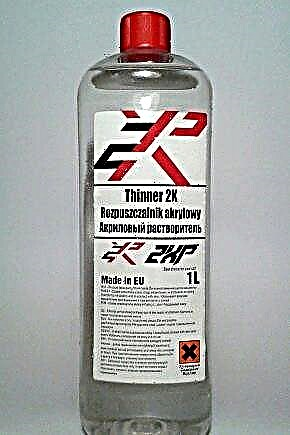
A paint thinner is an organic volatile composition that is used to give the materials on the paint base the desired consistency.
These compounds will be discussed in our article.
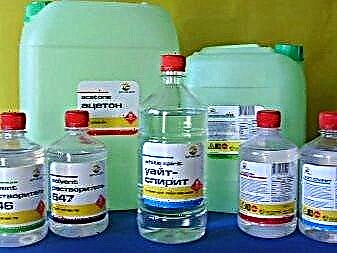

Features
Before purchasing the product, you need to find out which solvent is suitable for which paints.
If the material you purchased is not intended to work with a certain type of paintwork, as a result of mixing them, most likely, an uncontrolled chemical reaction will occur that will ruin your paint.
Solvents are substances that can dissolve enamel coatings. Then they disappear, thereby weakening the paintwork. Thinners are formulations that allow you to dilute the paint and help create a uniform film.
There are universal solvents, the scope of which is almost unlimited. A characteristic feature of a number of solvents for paints and varnishes is a pungent odor that cannot be confused with the “aroma” of other materials. In addition, many of them can be attributed to toxic substances, therefore, when working with them, certain safety measures must be observed.


Water dispersion
- Water based acrylic paints widely used for interior work. They have high decorative qualities. Despite the fact that water is used as a diluent, after drying, a strong layer appears on the surface. Fresh smudges of paint can be easily cleaned with a cloth dampened with water. If the coloring matter on the brushes has managed to dry, then it can be wetted with a warm solution of soap and water.
As a solvent for acrylic paint, gasoline, acetone, white spirit, and also kerosene are used. His choice will directly depend on the surface being cleaned.
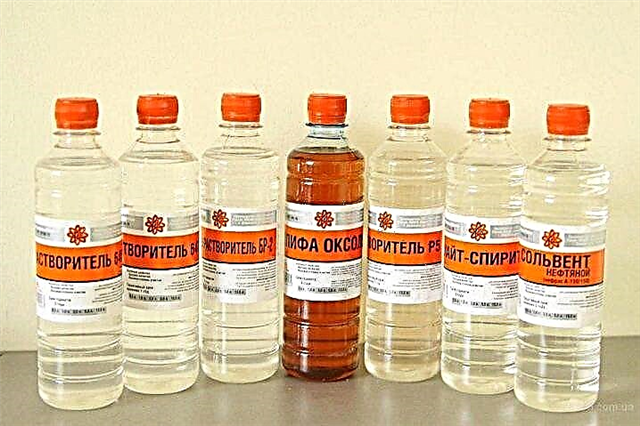
- Latex paint used for coating surfaces of various materials. Such a tool forms a strong and dense layer. To obtain the desired viscosity, the paint is diluted with water. After completing the painting, tools and drops on objects are immediately washed with water.
Dried drops can be removed with toluene or methylbenzene. These elements are part of organic solvents such as P-4, P 646, 647 and 648. Such funds should be used quite carefully to, for example, remove paint droplets from the floor. Here you can choose the most gentle method - soak stains with water, in which kerosene is added.


- Polyvinyl acetate paint it is applied on plastered, wooden or plasterboard surfaces. The coloring matter is quite easily cleaned with an ordinary sponge soaked in a solution of warm water and soap. Individual drops are simply removed mechanically with a knife or a special spatula.
Already dried polymer film can be wetted with water and heated with a hairdryer. The softened layer is removed without effort.
Old contaminants are removed with acetic acid, white spirit, acetone, benzene.


- Silicone paint forms a reliable layer, not afraid of water. Fresh stains are removed with a dry and damp cloth. For dried drops, mechanical means are used. Old contaminants are cleaned with hydrocarbon-based solvents or ether and ester components. Such chemical fluids should be used with care on plastic surfaces.

Alkyd Oil
- Oil paint - the most affordable type among these products. Fresh drops are wiped off with a rag soaked in a solvent for oil paint. White spirit, turpentine, kerosene, refined gasoline (nefras), butanol or ammonia are excellent for these purposes. Since the paint forms a fairly durable coating, old dirt is removed with difficulty. As solvents of old paints, numbered compositions P 647, 651 can be used.


- Alkyd paint able to penetrate deeply into the surface structure, due to which a strong, resistant layer is formed. Drops of HF enamels are easily removed with turpentine or white spirit, PF - with xylene, solvent or gasoline, as well as their mixture 1: 1, KO - P-4, P-6, solvents N 646, 649, 650. For old dirt, you can use special means - washes. When working with them, you should be careful, since their effect may not be limited to the paint itself. The active substance can dissolve all the original layers of the primer or putty.
Nitro enamels
Nitro-paint is used to paint various surfaces, primarily metal structures. The best solvents for NTs paint are the combined formulations N 645, 646, 647, 649, 650. They are used as thinners of thickened enamel, as well as for degreasing surfaces, removing paint residues from construction tools. It is possible to clear pollution with rags moistened in acetone, ethyl acetate and other similar products of group of simple and complex ethers.

Epoxy materials
Epoxy paint has several advantages. However, its excellent strength and resistance to many chemicals has another side - well-dried material is almost impossible to remove. Fresh spots are removed as quickly as possible with a dry and clean cloth.
If the spots were not noticed on time, then it is worth using the mechanical method. If the droplets are large, you can use the numbering composition P-5, P-14, P-40, P-83.


For paint work on a metal surface, hammer paint is often used, for which solvents such as xylene (orthoxylene) or solvent are used. The composition of polyurethane varnishes includes a solution of a polyurethane oligomer in a mixture of organic solvents.
In order to choose the right solvent for polyurethane varnishes, it should be remembered that acetates should be in its composition and nitrocom components, alcohols and gasolines should not be. In order to dilute the polyurethane varnish to the desired viscosity, solvents R-4, R-4 A are usually used.

For oil paints and varnishes
- Petrol. It is considered the simplest and most common solvent that can be used for this group of products. Gasoline is used as a solvent for oil paints and alkyd enamels, as well as varnishes and putties. Less commonly, it is used to dilute pentaphthalic enamels.
- Turpentine. It is used as a solvent for oil and alkyd-enrol enamels and paints. Used for the preparation of many varnishes based on copal, rosin, as well as dammar.
- White Spirit. This solvent is used to dilute most of the known paints, varnishes and other products (for example, it is an excellent thinner for PF-115 enamel). It is also used to dilute the primer or drying oil, bituminous material, putty, wash your hands after using paints and enamels. Also used for degreasing surfaces.
For glyptal dyes and bitumen varnishes
- Solvent - a mixture that consists of aromatic carbohydrates, in which there is a certain content of naphthenes, as well as paraffins and other cyclic carbohydrates. The solvent is used as a substance for dissolving oils and bitumen, most types of rubbers and oligomers. It is used as a means for diluting polyetheramides and other paints and varnishes, which may contain a small amount of melamine-alkyd substances.
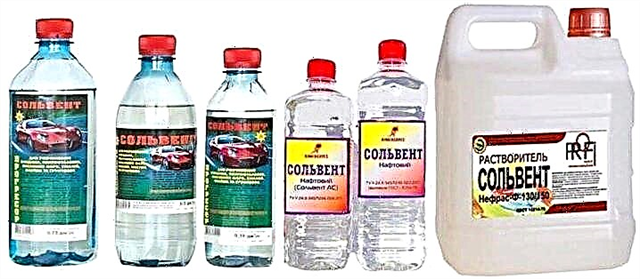
- Xylene. It is used to dissolve electrical insulating paints, varnishes and most enamels, organosilicon varnishes, as well as epoxies. There is one caveat here: it is fire and explosion hazard.

Perchlorovinyl paint and varnish solvents
- Acetone. It is used as a solvent for natural resins and oils, diacetate and other substances, such as cellulose and polystyrene, epoxy resin and copolymer, chlorinated rubber and so on. Suitable for use with enamel NTs 132, brand XB, etc.
- Acetone is found in other mixed solvents, which are referred to as P-4 and P-4 A, as well as 646-468 and P5 (A). These are number reductions of solvents that are indexed that way. They are made both for dissolving paints and for other household needs (suitable for dissolving the base of metallic paint).
- Solvent 646. It is a very effective and useful chemical product. Helps to dilute nitro enamels, nitro-varnishes and epoxy compounds, other paints and varnishes.

Alcohol Compounds
- Ethanol. Very toxic, this solvent for acrylic paints is used in decoration for breeding pigments, degreasing surfaces, etc.
- Methyl and Butyl Alcohol. Similar in composition to ethanol, but are more toxic, they are used to dilute paints and varnishes based on nitrocellulose.
- Ethylene glycol. It mixes well with water, evaporates for a long time, which can significantly slow down the polymerization of nitro-lacquers.

Consumption
Each of the solvents used during the work will require a certain ratio with paintwork materials during painting. Wherein most often it is indicated not the solvent consumption per 1 kg of paint, but the percentage or amount of material per square meter.
For example, 110-160 g / m² is the recommended consumption for mineral spirits if you use it for oil paints. And PF 115 enamel will need to be diluted with solvent, white spirit, turpentine, or a mixture thereof in a 1: 1 ratio. In order not to get very disappointed with the dissolution of the paint, it is best to familiarize yourself with the features of this process in the instructions for its use.

Tips
The correct choice of solvent, depending on the composition of the paint material, will help to avoid rapid coagulation, blistering or cracks after applying the paint. When removing contaminants formed by these materials, the most suitable solvents should be selected.
In the cleaning process, one should rely not so much on the amount of solvent chosen as on the mechanical effect to remove dried paint from metal or wood.
That is, thoroughly rubbing just a few drops of a liquid substance may be sufficient to remove even heavy contaminants.

Many solutions for removing paint (including powder) have aggressive chemicals in their composition, so you should be extremely careful when working with them:
- protect yourself with gloves, a respirator, glasses,
- work in well-ventilated areas
- in case of contact with mucous membranes, immediately rinse these areas with clean water and seek medical help.
How to dilute the paint, see the next video.
Why dilute oil paints?
For creative works, artists use oil paints, the main advantages of which are:
- thick structure
- wide color gamut
- ease of mixing
- easy to correct mistakes made during work.
In diluted form, oil paints are an excellent material for painters. They have written many immortal works of art at all times. But such compositions dry out quickly, so they need to be diluted. Solvents for painting make paints more fluid, making it easier for the artist. Compositions for writing pictures are odorless, therefore absolutely safe.

How to breed oil paints? You can dilute them with a solvent with white spirit in the composition. But for coloring pigments, oil is a binder component. Therefore, professional artists recommend diluting oil paints with a special thinner, which consists of vegetable oils.
The drying time of the applied image depends on the amount of oil in the paint. Do not add a lot of thinner to the paint, since the oils do not evaporate when dried. An ideal ingredient for paint dilution is poppy seed oil.

The main types of diluents
There are four groups of diluents for oil paints, which are used in their work by masters of art brushes:
- on vegetable oil,
- on the varnish
- "Double" and "tee",
- the diluent is pinene.
Every artist knows how to dilute oil paints. In addition, he knows very well how to dilute oil paint. The composition of the diluent includes turpentine, white spirit and pinene. It is sold under different numbers depending on the composition.
Butter
One of the usual types of thinners that have been used for painting for a long time is vegetable oil. Hence the name of oil art paints. They produce oil from flaxseed, sunflower, hemp and poppy seeds.

An oil-based paint thinner is also a varnish in which a dilute resin is used. Thanks to the use of varnish, the paint structure becomes more dense and keeps on the canvas much stronger. Such varnishes are added to solvents for art oil paints.

Double and tee
In a painting, a solvent double is called a diluent, which includes two components: varnish and oil. Moreover, these two components are mixed in certain proportions, or rather, 1 part of varnish + 2-3 natural oils.
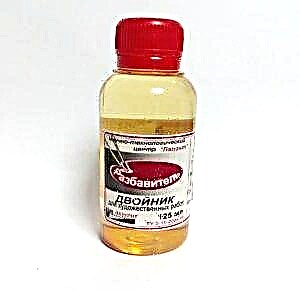
“Tee” is a composition in which, in addition to the main two components, the third component is a diluent.

Pinen
Thinner No. 4 for oil paints has a different name - pinene. It is used to dissolve and dilute formulations. Such solutions are easily applied to the drawing. 
Masters of the brush choose how to dilute the paint, depending on the task ahead. Oil paintings amaze the imagination of visitors to museums of all countries, which contain masterpieces of great artists of all time.
On the video: in detail about thinners for oil paints.
How to dilute the paint
As solvents that artists use, it is better to use vegetable or linseed oil. As a rule, diluted paints change a bright color to a dull one, but after drying, the original shade returns.
It is necessary to dilute the compounds carefully, an excess solvent can make them loose, depriving the natural properties. To the question whether it is possible to achieve a milder effect when the paint is dissolved, there is a definite answer - yes. You just need to dilute slowly, check on a trial canvas. If you overdo it with a solvent, then on the canvas the paint will not hold well.
With the right ratio of composition and solvent, the paint is firmly fixed on the canvas.

Oil solvents are created for paints used in art. To choose a solvent for oil paint you need one that does not have an odor. For example, it can be a mixture of turpentine and white spirit in equal proportions.
Additional Information
Binders are an essential component in the production of oil paints. These include oils, which when dried form a protective film on the surface of the picture. Thanks to her, the canvases of great creators are stored for centuries.
Thinners for oil paints are used to reduce the viscosity of paints during operation. Terpenes and white spirit are also used for painting.

Those wishing to paint should choose the right pigment number, find a good solvent, choose high-quality brushes and take care of them.Foreign sales samples of solvents are presented on the sales market. This gives the consumer a wide choice of materials for diluting oil paints.

Oil paint dries on the brush, so at the end of work it must be thoroughly washed. Do not leave brushes in the paint. It is important to dry a cleanly washed brush to prevent mixing of paints. Also, do not allow drying of the paint on your hands.
When using oil paints, you must follow the drawing sequence, the rules for using paints and brush care. Paints must be properly prepared using the right solvents.
What are the most popular solvents for enamel?
Solvents are organic compounds used to prepare paints and varnishes for work by giving them the desired consistency. All products on the market are classified by the composition and functions of those products for which they are intended to work - varnishes, enamels, paints, etc.
Solvents for enamels are characterized by versatility, belong to the category of quick-drying chemical compositions, give the right tone and gloss to paints.
- Acetone It is an almost universal tool for cleaning any surface from dirt. The chemical composition of this enamel solvent is such that it can be mixed with water and has the ability to break down complex fats. The drug looks like a colorless liquid, volatile and rapidly evaporating.
- White Spirit also evaporates quickly. Due to the lack of smell, this solvent for alkyd enamels is perfectly suitable for use in closed, unventilated rooms.
- Turpentine - clear liquid with enhanced solvent properties. It is characterized by a strong tarry odor, so it is possible to work with the product only in aired or equipped with ventilation rooms. The scope of the solvent is enamels with high viscosity, drying oils (it accelerates their drying).
- Xylene one of the best solvents for enamels, paints and other coatings. This transparent liquid in its chemical composition is a mixture of organic substances - aromatic carbohydrates. It has a specific odor and high solubility in relation to various coatings, which provides this tool with a very wide range of applications. Orthoxylene is used to give the composition (enamel, varnish, etc.) a working viscosity, which is required when applying paintwork with a spray gun.
- Solvent formed by evaporation of petroleum products. Such tools are suitable for working with a wide range of different coatings. They have a high dissolving power, evaporate almost instantly when applied to the treated surface and take away all the odors.

In the construction and automotive industries, oil and stone solvents (for example, Nefras A 130/150) are actively used as solvents for enamels and alkyds, which need to be brought to the necessary density. In addition, this type of solvent is used to dilute phenols, epoxyesters, polyacrylates, organosilicon, melamine alkides, alkyd-urethanes and alkylo-styrenes, as well as some other, not so common means.
- Kerosene, which is a mixture of various hydrocarbons in which the number of carbon atoms varies from 9 to 16 (limit, unsaturated, naphthenic, bicyclic aromatic and other hydrocarbons obtained during the processing of oils of various compositions), it is mainly used to prepare surfaces for painting (degreasing). Also using this tool remove the grease and dilute the paintwork. As a solvent, it is suitable for working with enamels and other means.
What is the difference between solvents and thinners for enamel
Often the concepts of “solvent” and “diluent” are used as synonyms, but this is not entirely correct, since they differ significantly in terms of mode of action and purpose. These are two groups of different materials, and it is important to understand what the differences are between them, what composition should be used to dilute one or another coat of paint, and why you should not save on these funds.
First, let's define the terminology. Here are the definitions of these concepts are given in the "Guide to paints and varnishes."
A solvent is called a substance (alcohol, ketone, ether, hydrocarbon, etc.) or a mixture of various substances used to dilute coatings to reduce their viscosity in order to translate into the desired state (suitable for applying material to the surface to be treated).
A thinner is a volatile organic substance in a liquid state, which is used to lower the viscosity of coatings and prepare them for painting the surface.
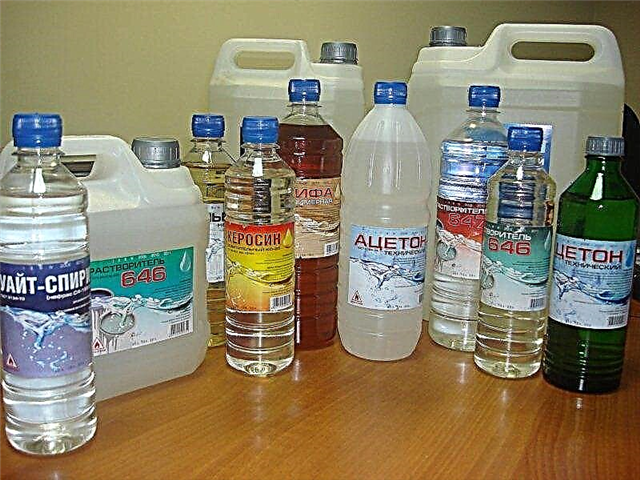
Obviously, each of the terms reflects its essence.
To solvents, first of all, are liquids added to enamel, varnish, etc. at the production stage, even at the factory. The binder, which serves as the basis for coatings, exists either in a solid or in an extremely thick state and without a solvent it cannot be brought into the form necessary for further use. The solvent provides a liquid state of enamel, primer, etc. until painting and does not allow the composition to dry until it is applied to the surface.
Thus, we can conclude that the solvents, under the influence of which the structure of the ingredients of coatings vary so significantly, are quite aggressive reagents.
Recommended Related Articles:
Thinner is less aggressive: they do not dissolve the resin, which is the basis of enamel or paint, like solvents, but only bring its solution to the desired degree of viscosity.
As a rule, compositions topped up in soils, paints and varnishes do not dissolve anything before starting to work with them, but only adjust the viscosity. In fact, these agents act as diluents.
Which solvent to use for alkyd enamels
Alkyd-based enamels are widely used in car repair as a means for painting. Alkyd enamels are practical and do not dry out during the staining process (even if you do not add acetic acid, which is actively supplied by the factories of the Rostov region), so it is convenient to work with them.
It is enough to dilute the alkyd enamel a little so that it acquires good contact with the surface and evenly distributes on it, forming at room temperature (+15 ° С ... + 25 ° С) for a period of 24–48 hours a strong shiny film that is resistant to deformation and protects the material .

As for the Russian paint and varnish market, the closest in their properties and scope to automotive alkyd enamels used to repair vehicles and agricultural machinery are alkyd-pentaphthalic enamels of the PF-115 and PF-133 grades, as well as AC- alkyd-acrylic enamel 182.
Thinners for alkyd enamels are:
- xylene
- solvent
- solvent r-5,
- turpentine,
- a mixture of xylene (sometimes solvent) and white spirit.
Solvents for alkyd enamels, as well as enamels themselves, are selected depending on the required properties and characteristics, taking into account safety for the human body. Not every alkyd enamel is suitable for painting walls of interior rooms, furniture - some products are very toxic.
Solvents for alkyd enamels are extremely diverse in chemical composition, and you need to choose a tool based on its characteristics. If you do not want to mix the solvent with enamel yourself before starting work, you can purchase such products, which initially include the solvent.
Synthetic Enamel Solvent
This type of enamel, better known as nitro enamel, from a chemical point of view is an enamel paint based on cellulose nitrate. This substance is formed by exposure to cellulose nitric acid.
If it is necessary to paint a small area with synthetic enamel by spraying, it is recommended to overlap its borders with a special mixture of solvents to prevent dusting: mix seven parts of xylene (or coal solvent) with one part of turpentine.

The main advantage of nitro enamels is almost instant drying. Such coatings dry faster than everyone else: complete drying occurs within 10-30 minutes at room temperature, and without any drying equipment. Needless to say, for finishing work it is very convenient.
However, such quick drying can create a problem for the painter, so synthetic enamels are applied, as a rule, by means of spray guns. When painting with a brush, smudges and protruding areas are inevitably formed. They are painted with nitro enamel very quickly. It is necessary to apply it in several layers, taking between them breaks of 20-30 minutes to dry and making sure that the layers are the same in thickness.
Immediately upon completion of work, until the enamel has solidified, the channels, tank and other parts of the atomizer in contact with the coloring composition are washed with a solvent.
In addition to the drying speed, nitro enamels have other pluses: the surface, covered even with a thin layer of this paint, is smooth and mirror-like, pleasing not only with beauty, but also with its physicochemical characteristics.
Most often, synthetic enamel is sold in a ready-to-use form and does not require the use of solvents. It is enough to stir the coloring composition.
Defects and splashes of enamel that have arisen during staining are removed using solvents such as:
What solvent is needed for acrylic enamel
The binder in acrylic enamels and paints are polyacrylic polymers. Acrylic, which is widely used as plexiglass, is produced by hydrolysis of lactic acid. Acrylic paints can be water or lacquered. In order to give the composition elasticity and make it resistant to external influences, various additives and additives are introduced into acrylic enamel.

Acrylic enamels and paints are usually less bright and have a more matte texture compared to other coatings. The range of these tools is very extensive: funds are issued for construction and repair work (including the processing of rusty surfaces), for artistic needs. Acrylic is almost invulnerable to precipitation, frost and other environmental influences, which makes it a suitable material for facade finishing work.
It is possible to clean the tools and containers involved in working with acrylic coatings with plain water; any special solvents for acrylic enamels are not required. Thanks to this, the equipment used to mix the coloring solution is stored longer. The formulation of acrylic enamels is designed in such a way as to provide certain chemical reactions between the elements and as a result to obtain a substance that does not react with other substances and mixtures.
Hammer enamel thinner
To the class of "hammer enamels" belong those paintwork materials that form a unique texture on the painted surface, resembling metal processed by hammer blows. It resembles copper jugs made by hand, or coinage.
Imitation of a metal uneven surface is obtained thanks to the special components contained in such enamel: metal powder, aluminum flakes, resins and silicones of various kinds. They create this original effect.
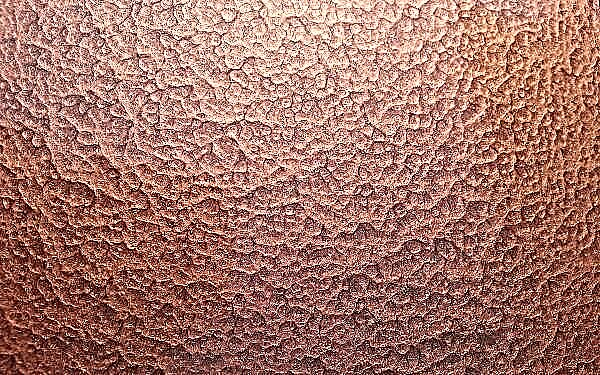
Hammer enamel is characterized by maximum resistance to all weathering, mechanical damage, and vibration. This invulnerability is provided by enamel, its base - alkyd-styrene, epoxy or acrylic - and a filler that has high adhesion to metals and is not subject to corrosion. As a filler for hammer enamels, aluminum powder or fine glass is used.
Xylene is usually used as a diluent for hammer enamels to the desired viscosity.
To breed such enamels is permissible only if absolutely necessary. The fact is that a diluted hammer enamel forms smudges on the surface and gives a not so embossed texture. If you encounter these problems, add a 10% solution of silicone oil in xylene to the enamel (in the ratio of 1% solution to the total enamel mass) and mix gently. Exceeding the dose of the silicone oil solution will make the enamel pattern too small.
Xylene is also used as a solvent for hammer enamel, but in shops you can find special tools, so-called solvents for hammer enamel.
What you need to know when choosing enamel solvents
Many high-quality solvents for enamels, varnishes and paints are on sale. But you should choose them carefully and carefully. One and the same agent can act on different coatings in a completely different way, and what is a diluent for one resin will become an aggressive solvent for another.
Using solvents that are not suitable for your coloring composition, be prepared for the fact that the funds will be incompatible, the consequences will be rather unpleasant, staining may simply not work.
In some cases, however, an unregulated diluent can very positively affect enamel or other coatings: its macromolecules will change their configuration (“squeeze the paws”), as a result of which the viscosity will decrease very effectively. But such a diluent should not interfere with the formation of the film, and this happens very often when using “non-native” diluents and solvents for enamel.
All solvents and diluents are created strictly for a specific coat of paint so as to be combined with the base of the product and all its additives. The manufacturer of the solvent for enamel, varnish or paint does not just mix the components, but thinks over the order and speed of chemical reactions in the preparation of the product.
The choice of solvent will affect the speed of drying the enamel, and the quality of the resulting paintwork (its strength, gloss and other properties). Therefore, it is so important to use only branded and compatible with paintwork materials: if you replace the regulated product with something else, there is a risk of unsuccessful coloring.
However, such substitutions of a “native” diluent or solvent with a “foreign” one are practiced everywhere. Masters buy expensive enamels, paints and primers, and for the dilution choose the cheapest liquid. When problems arise, the master blames all the problems of the paintwork manufacturer.

We do not mean that any solvent for enamel or other coatings is definitely bad. Not at all. In combination with the brand of household or industrial paint, enamel, etc., for which they were developed, even inexpensive solvents give excellent results. For example, a series of solvents No. 645–651 was created for use in conjunction with nitro enamels (as reflected in the instructions for each product), but it is completely unsuitable for diluting modern, especially foreign, paint and varnish compositions.
Thus, the easiest and most correct way is to read the recommendations for choosing a solvent on the packaging of the enamel itself and follow it. Reliable companies manufacturing coatings indicate in the instructions which solvents are combined with their product. But if there is no such information on the product label, then you can use the recommendations from our article: in most cases they work. Another option is to consult with a master who has already dealt with the enamel that interests you. Acting at random is not necessary.
Where to buy high-quality and safe paints for wood
Raduga JSC has been operating since 1991 (formerly Tsentrmebelkomplekt, Decor-1). The company was organized to supply raw materials to enterprises that are part of Centromebel CJSC.

Today, the company's permanent business partners are not only Russian manufacturers, but also leading companies in Germany, Austria, France, Italy, Switzerland, Finland, Poland, Sweden. Our office is located in the center of Moscow, as well as our own warehouse complex with an exhibition hall of 200 m².
In our warehouses located in the near Moscow region, there is always a large selection of raw materials, materials and components for the production of furniture and joinery. In the assortment of more than 300 types of varnishes and 400 types of dyes, emphasis is placed on the sale of varnishes and dyes with a dry residue.
At the request of customers, our team for one or two days produces polyurethane enamels in almost all colors. We offer adhesives from five leading manufacturers in Europe, natural veneer and lumber - more than 60 types of ordinary, exotic and exclusive species. Front and mounting accessories are constantly available - more than 4000 items from manufacturers from Europe: Austria, Poland, Germany, etc.
Every month we process applications from more than 1800 customers. These include both large furniture factories and private entrepreneurs.
Deliveries of goods are carried out throughout Russia. Our company delivers goods for free in Moscow. Products are shipped by road to all regions of Russia.
Our company takes seriously the training of our own specialists. Managers systematically undergo internships in companies engaged in the production of finishing materials in Germany, Italy, Austria, and Finland. The employees of our company provide technical assistance to customers.
We invite you to cooperate on mutually beneficial conditions! We value our customers and try to find an individual approach to each customer.



